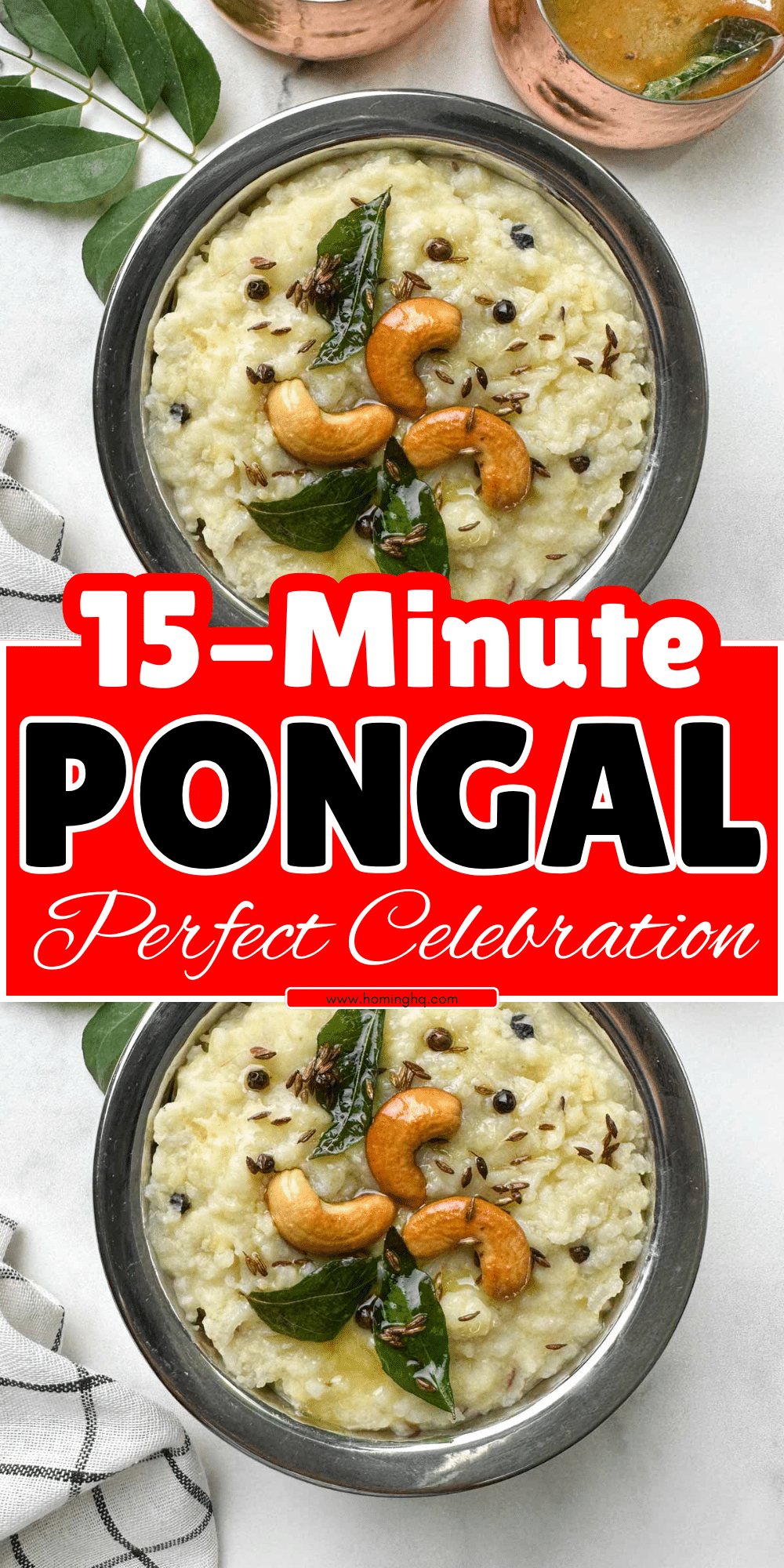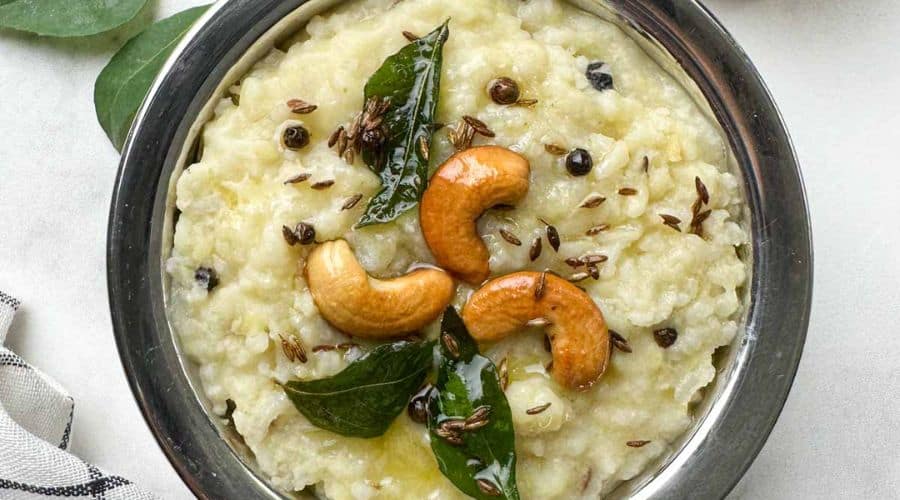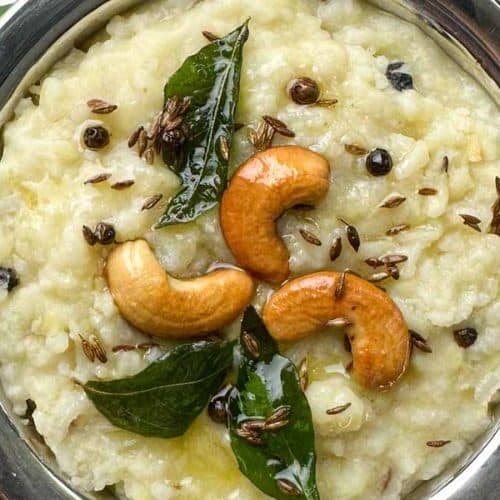All products are selected by our editorial team for quality. If you buy through our links, we may earn a small commission at no extra cost to you.
Pongal is a beloved South Indian dish that has its roots deeply entrenched in the culture and cuisine of Tamil Nadu.
Traditionally enjoyed during the harvest festival of Pongal, this dish is a symbol of prosperity and gratitude for the bountiful harvest.
Pongal comes in two primary varieties: Ven Pongal (savory) and Sakkarai Pongal (sweet).
Both versions are comforting and rich in flavor, making them perfect for a hearty breakfast or as part of a festive meal.
Whether you are new to South Indian cuisine or a seasoned enthusiast, Pongal is a dish that brings warmth, flavor, and joy to any table.

Ingredients for Making Pongal
Ven Pongal (Savory) Ingredients
To prepare a delicious Ven Pongal, you will need the following ingredients:
- 1 cup rice
- 1/4 cup moong dal (yellow split lentils)
- 2 tablespoons ghee (clarified butter)
- 1/2 teaspoon cumin seeds
- 1/2 teaspoon black pepper (whole)
- 1-inch piece of ginger (finely chopped)
- A few curry leaves
- 8-10 cashews
- Salt to taste
Sakkarai Pongal (Sweet) Ingredients
For the rich, sweet version of Pongal, gather the following ingredients:
- 1 cup rice
- 1/4 cup moong dal (yellow split lentils)
- 3/4 cup jaggery (grated or in solid chunks)
- 2 tablespoons ghee (clarified butter)
- 8-10 cashews
- 1/2 teaspoon cardamom powder
- A handful of raisins (optional)
- 2 tablespoons coconut (grated, optional)
Step-by-Step Instructions to Make Ven Pongal

Preparing the Rice and Moong Dal
To start, rinse rice and moong dal separately under cold water. After washing, soak them together for about 20 minutes.
Soaking helps the grains cook more evenly and improves the texture of the final dish.
While the rice and dal are soaking, dry roast the moong dal in a pan for a minute or two.
This step enhances the flavor of the dal and adds a slightly nutty aroma.
Cooking the Pongal
In a pressure cooker, add the soaked rice and dal along with 3 cups of water.
Pressure cook for 3-4 whistles or until the rice and dal are fully cooked and soft.
The consistency should be slightly mushy but not watery.
Once done, open the cooker, and gently mix the rice and dal together to ensure a smooth consistency. Set aside for tempering.
Tempering the Pongal
In a separate pan, heat the ghee over medium heat.
Add cumin seeds and let them splutter. Next, add the black pepper, chopped ginger, and curry leaves.
Sauté for a few seconds until the aroma of the spices fills the air.
Now, add the cashews and fry until golden brown. Once the tempering is ready, pour it over the cooked rice and dal mixture.
Stir gently to combine, and adjust salt to taste.
Serving and Garnishing
Serve the savory Ven Pongal hot, garnished with additional fried cashews and curry leaves.
It pairs wonderfully with coconut chutney and sambar, making it a complete and satisfying meal.
Step-by-Step Instructions to Make Sakkarai Pongal
Preparing the Rice and Moong Dal
For Sakkarai Pongal, rinse rice and moong dal under cold water, then soak them for about 20 minutes.
Dry roast the moong dal in a pan just as you did for Ven Pongal to bring out its aroma.
Once done, add the soaked rice and dal to a pressure cooker with 3 cups of water.
Pressure cook for 3-4 whistles or until the mixture is soft and mushy. Stir the rice and dal gently to blend them, ensuring an even consistency.
Making the Jaggery Syrup
While the rice and dal are cooking, take a separate pan and melt the jaggery over low heat.
Add about 1/2 cup of water to the jaggery and let it dissolve.
Once it has completely melted, strain the syrup to remove any impurities.
Continue to cook the syrup until it reaches a slightly sticky consistency but isn’t too thick.
Combining Rice, Dal, and Jaggery
Add the jaggery syrup to the cooked rice and moong dal mixture.
Stir gently to combine, ensuring the syrup is evenly distributed throughout the rice.
Continue to cook the mixture on low heat for a few minutes so that the flavors meld together.
Add the ghee and cardamom powder, stirring once more to infuse the Pongal with a rich, fragrant flavor.
Serving and Garnishing
Once the sweet Pongal reaches the right consistency, remove it from the heat.
Garnish with fried cashews and raisins for an extra touch of texture and flavor.
Sakkarai Pongal can be served warm, and it pairs beautifully with a side of coconut milk or fresh fruit if desired.
Tips for Perfect Pongal
Adjusting Spice Levels for Ven Pongal
If you prefer a milder Pongal, reduce the amount of black pepper and cumin seeds.
For a spicier kick, feel free to add a pinch of crushed black pepper or even finely chopped green chilies during tempering.
It’s all about personal preference, so adjust the seasoning to your taste.
Consistency is Key
For Ven Pongal, the rice and dal should be soft and slightly mushy, but not too watery.
If you find the consistency too dry, add a little more hot water or ghee to achieve a creamy texture.
For Sakkarai Pongal, make sure the rice and dal mixture is soft enough to absorb the jaggery syrup, but it should still hold its shape when served.
Use Fresh Ingredients
Using fresh ghee, curry leaves, and spices like cumin and black pepper will greatly enhance the flavor of your Pongal.
Fresh jaggery will give your sweet Pongal a rich and authentic taste, so try to avoid using packaged jaggery that may have been sitting for a long time.
Perfect Tempering
For the best flavor, make sure the ghee is hot enough to properly roast the cashews, cumin, and black pepper. However, be careful not to burn the ghee or spices.
The perfect tempering adds a nutty aroma to your Pongal and elevates the overall taste.
Serving Warm
Pongal is best enjoyed hot and fresh. If you need to store it for later, reheat gently with a splash of water or ghee to maintain its texture and flavor.
Common Mistakes to Avoid While Making Pongal
Overcooking or Undercooking Rice and Dal
One of the most common mistakes when making Pongal is overcooking or undercooking the rice and dal.
The consistency should be soft and slightly mushy, but not soupy or overly dry.
Always monitor the cooking time, especially when using a pressure cooker, to ensure that the grains are perfectly cooked without turning too sticky or mushy.
Burning the Ghee or Spices
Tempering the spices in ghee is a critical step, but it requires careful attention.
Burning the ghee or spices like cumin and black pepper will give the Pongal a bitter taste and ruin the dish.
Be sure to keep the heat on medium and stir constantly to avoid this.
Using the Wrong Consistency of Jaggery Syrup
When making Sakkarai Pongal, the jaggery syrup must be cooked to the right consistency—sticky but not too thick.
If the syrup is too thin, the Pongal will be watery; if too thick, it can make the dish too sweet and sticky.
Always test the syrup consistency by dropping a small amount into cold water. It should form a soft, sticky ball.
Not Adjusting the Flavor Balance
If your Pongal lacks flavor, check the salt in Ven Pongal and the sweetness in Sakkarai Pongal.
Sometimes, a pinch of extra salt or jaggery can balance the overall taste.
Additionally, a touch of fresh curry leaves or a dash of cardamom can enhance the aroma and flavor.
Skipping the Roasting of Moong Dal
Roasting the moong dal adds an essential nutty flavor to both Ven Pongal and Sakkarai Pongal.
Skipping this step can lead to a bland dish. The small effort of roasting the dal will significantly improve the final taste.
By following these tips and avoiding common mistakes, you can create the perfect Pongal every time.
Enjoy the warm, comforting flavors of this classic South Indian dish!
Serving Ideas for Pongal
Serving Ven Pongal
The savory Ven Pongal is typically enjoyed as a hearty breakfast or a satisfying lunch.
It pairs wonderfully with the following accompaniments:
- Coconut Chutney: The creamy, refreshing taste of coconut chutney complements the spices in Ven Pongal perfectly.
- Sambar: A flavorful South Indian lentil stew, rich in vegetables and tangy tamarind, is the perfect side dish for savory Pongal.
- Rasam: For a slightly tangy and spicy variation, rasam adds a nice balance of flavors when served with Ven Pongal.
Serving Sakkarai Pongal
The sweet Sakkarai Pongal is often enjoyed during festivals, celebrations, or as a dessert.
You can enhance the experience by pairing it with:
- Coconut Milk: A drizzle of fresh coconut milk on top of Sakkarai Pongal adds creaminess and enhances the dish’s rich flavors.
- Fruits: Fresh fruits like banana slices or even a little bit of mango pulp can balance the sweetness and make for a refreshing contrast.
- Curd (Yogurt): Some people like to serve Sakkarai Pongal with a dollop of yogurt on the side to cut through the richness of the dish.
Both versions of Pongal are versatile and can be paired with various sides based on your preference and occasion.
Conclusion
Pongal is more than just a dish; it is a comforting, flavorful tradition that brings people together.
Whether you enjoy it savory or sweet, Ven Pongal and Sakkarai Pongal offer a taste of South Indian hospitality, with their rich aromas and simple ingredients.
Both versions are incredibly versatile and can be enjoyed for breakfast, lunch, or as part of a festive meal.
By following the right techniques, using fresh ingredients, and avoiding common pitfalls, you can create the perfect Pongal every time.
So, whether you’re preparing Pongal for a special occasion or as an everyday meal, it will undoubtedly bring warmth, joy, and a touch of tradition to your kitchen.
Don’t forget to experiment with different serving ideas to make your meal even more delightful!
Frequently Asked Questions
1. Can I make Pongal without ghee?
Yes, you can make Pongal without ghee for a vegan version. You can replace the ghee with coconut oil or any neutral oil.
However, ghee gives a unique richness and flavor to the dish, so it’s recommended for the most authentic taste.
2. Can I use brown rice instead of white rice for Pongal?
Yes, you can use brown rice instead of white rice, but it may take longer to cook and the texture will be slightly different.
Brown rice will add more fiber and a nuttier flavor to the dish.
3. How do I store leftover Pongal?
Leftover Pongal can be stored in an airtight container in the refrigerator for up to 2-3 days.
To reheat, add a little water or ghee to restore the moisture and texture. Avoid freezing Pongal, as it can alter the consistency of the dish.
4. Can I make Pongal without moong dal?
Moong dal is an essential ingredient in Pongal, but if you’re allergic or prefer to skip it, you can substitute it with yellow split peas or even lentils.
Keep in mind that the texture and flavor may change slightly.
5. Can I make Pongal in advance for a gathering?
Yes, you can make Pongal in advance. To keep it fresh for a gathering, store the cooked Pongal in the refrigerator and reheat it just before serving.
You can also prepare the tempering (ghee, spices, and cashews) separately and add it to the Pongal when ready to serve.

Pongal
Equipment
- Pressure Cooker (1)
- Pan (1)
- Spatula (1)
- Strainer – 1
Ingredients
For Ven Pongal (Savory)
- 1 cup – Rice
- 1/4 cup – Moong dal yellow split lentils
- 2 tablespoons – Ghee clarified butter
- 1/2 teaspoon – Cumin seeds
- 1/2 teaspoon – Black pepper whole
- 1- inch piece – Ginger finely chopped
- A few – Curry leaves
- 8-10 – Cashews
- Salt – To taste
For Sakkarai Pongal (Sweet)
- 1 cup – Rice
- 1/4 cup – Moong dal yellow split lentils
- 3/4 cup – Jaggery grated or in solid chunks
- 2 tablespoons – Ghee clarified butter
- 8-10 – Cashews
- 1/2 teaspoon – Cardamom powder
- A handful – Raisins optional
- 2 tablespoons – Grated coconut optional
Instructions
For Ven Pongal (Savory)
- Prepare Rice and Dal: Rinse the rice and moong dal, and soak them together for 20 minutes. Dry roast the moong dal for a minute in a pan to bring out its nutty aroma.
- Cook Rice and Dal: In a pressure cooker, add the soaked rice, moong dal, and 3 cups of water.Cook for 3-4 whistles or until the rice and dal are soft and slightly mushy.
- Tempering: Heat ghee in a pan. Add cumin seeds, black pepper, ginger, and curry leaves. Fry for a few seconds until the aroma fills the air. Add cashews and fry until golden brown.
- Combine and Serve: Pour the tempering over the cooked rice and dal mixture. Stir well to combine and adjust salt to taste. Serve hot with coconut chutney or sambar.
For Sakkarai Pongal (Sweet)
- Prepare Rice and Dal: Rinse the rice and moong dal, soak them for 20 minutes, and dry roast the dal. Cook them in a pressure cooker with 3 cups of water for 3-4 whistles until soft.
- Make Jaggery Syrup: In a pan, melt jaggery with 1/2 cup water. Strain the syrup to remove impurities, then cook it further until it forms a sticky consistency.
- Combine Rice, Dal, and Jaggery: Add the jaggery syrup to the cooked rice and dal mixture, stirring gently. Cook on low heat for a few minutes to combine the flavors.
- Add Flavor: Add ghee and cardamom powder, mixing well.Garnish with fried cashews and raisins. Serve warm with coconut milk or fresh fruit.
Notes
- Adjust Sweetness: For Sakkarai Pongal, you can increase or decrease the amount of jaggery based on your desired sweetness.
- Consistency Tips: For Ven Pongal, the rice and dal should have a soft and slightly mushy texture. For Sakkarai Pongal, the rice and dal should absorb the jaggery syrup without being too dry or too watery.
- Vegan Option: To make a vegan version of Ven Pongal, replace ghee with coconut oil or any neutral oil.
- Leftovers: Both versions can be stored in the refrigerator for up to 2-3 days. Reheat with a little water or ghee to restore the texture.

